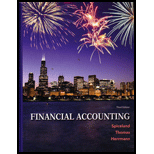
Financial Accounting
3rd Edition
ISBN: 9780078025549
Author: J. David Spiceland, Wayne M Thomas, Don Herrmann
Publisher: McGraw-Hill Education
expand_more
expand_more
format_list_bulleted
Question
Chapter 3, Problem 3.7APWC
To determine
To Describe: the concepts and appropriate means of making
Expert Solution & Answer
Want to see the full answer?
Check out a sample textbook solution
Students have asked these similar questions
Dont use ai.
step by step.
Accounting problem
What is the value of ending inventory using variable costing?
Chapter 3 Solutions
Financial Accounting
Ch. 3 - Prob. 1RQCh. 3 - 2.Discuss the major principle that describes...Ch. 3 - 3.Samantha is a first-year accounting student. She...Ch. 3 - 4.Describe when revenues and expenses are...Ch. 3 - Rip Side of Question 7 5.Executive Lawn provides...Ch. 3 - Prob. 6RQCh. 3 - Prob. 7RQCh. 3 - Consider the information in Question 7. Using...Ch. 3 - Prob. 9RQCh. 3 - There are two basic types of adjusting...
Ch. 3 - 11.Provide an example of a prepaid expense. The...Ch. 3 - Provide an example of a deferred revenue. The...Ch. 3 - 13.Provide an example of an accrued expense. The...Ch. 3 - Provide an example of an accrued revenue. The...Ch. 3 - Sequoya Printing purchases office supplies for 75...Ch. 3 - Jackson Rental receives its September utility bill...Ch. 3 - 17.Global Printing publishes several types of...Ch. 3 - At the end of May, Robertson Corporation has...Ch. 3 - Prob. 19RQCh. 3 - Prob. 20RQCh. 3 - Prob. 21RQCh. 3 - Prob. 22RQCh. 3 - Prob. 23RQCh. 3 - Prob. 24RQCh. 3 - Describe the debits and credits for the three...Ch. 3 - In its first four years of operations, Chance...Ch. 3 - Prob. 27RQCh. 3 - Prob. 28RQCh. 3 - Determine revenues to be recognized (LO31) Below...Ch. 3 - Prob. 3.2BECh. 3 - Prob. 3.3BECh. 3 - Analyze the impact of transactions on the balance...Ch. 3 - Prob. 3.5BECh. 3 - At the beginning of May, Golden Gopher Company...Ch. 3 - Record the adjusting entry for prepaid rent (LO33)...Ch. 3 - Prob. 3.8BECh. 3 - Prob. 3.9BECh. 3 - Prob. 3.10BECh. 3 - Prob. 3.11BECh. 3 - Prob. 3.12BECh. 3 - Prob. 3.13BECh. 3 - Prob. 3.14BECh. 3 - Prob. 3.15BECh. 3 - Prob. 3.16BECh. 3 - Prob. 3.17BECh. 3 - Prob. 3.18BECh. 3 - Prob. 3.19BECh. 3 - Prob. 3.20BECh. 3 - Consider the following situations: 1.American...Ch. 3 - Consider the following situations: 1.American...Ch. 3 - Refer to the situations discussed in E31....Ch. 3 - Differentiate cash-basis expenses from...Ch. 3 - Prob. 3.5ECh. 3 - Listed below are all the steps in the accounting...Ch. 3 - Prob. 3.7ECh. 3 - Prob. 3.8ECh. 3 - Prob. 3.9ECh. 3 - Prob. 3.10ECh. 3 - Prob. 3.11ECh. 3 - Prob. 3.12ECh. 3 - Prob. 3.13ECh. 3 - Prob. 3.14ECh. 3 - Prob. 3.15ECh. 3 - Prob. 3.16ECh. 3 - Prob. 3.17ECh. 3 - Prob. 3.18ECh. 3 - Prob. 3.19ECh. 3 - Prob. 3.20ECh. 3 - Consider the following transactions. Required: For...Ch. 3 - Prob. 3.2APCh. 3 - Prob. 3.3APCh. 3 - Prob. 3.4APCh. 3 - Prob. 3.5APCh. 3 - The year-end financial statements of Rattlers Tax...Ch. 3 - Prob. 3.7APCh. 3 - Prob. 3.8APCh. 3 - Consider the following transactions. Required: For...Ch. 3 - Prob. 3.2BPCh. 3 - Prob. 3.3BPCh. 3 - Prob. 3.4BPCh. 3 - Prob. 3.5BPCh. 3 - FIGHTING ILLINI Income Statement Service revenue...Ch. 3 - Prob. 3.7BPCh. 3 - Prob. 3.8BPCh. 3 - Prob. 3.1APCPCh. 3 - Prob. 3.2APFACh. 3 - Prob. 3.3APFACh. 3 - Prob. 3.4APCACh. 3 - Prob. 3.5APECh. 3 - Prob. 3.7APWC
Knowledge Booster
Similar questions
- I want to this question answer for General accounting question not need ai solutionarrow_forwardPlease help me solve this general accounting problem with the correct financial process.arrow_forwardPlease given correct answer for General accounting question I need step by step explanationarrow_forward
- I need help with this general accounting question using standard accounting techniques.arrow_forwardSolve this Accounting problemarrow_forwardIronforge Manufacturing, Inc., is a company that manufactures industrial equipment. During the year, Ironforge purchased $2,140,000 of direct materials and placed $1,970,000 worth of direct materials into production. Ironforge's beginning balance in the Materials Inventory account was $385,000. What is the ending balance in Ironforge's Materials Inventory account? Helparrow_forward
arrow_back_ios
SEE MORE QUESTIONS
arrow_forward_ios
Recommended textbooks for you
 Intermediate Accounting: Reporting And AnalysisAccountingISBN:9781337788281Author:James M. Wahlen, Jefferson P. Jones, Donald PagachPublisher:Cengage Learning
Intermediate Accounting: Reporting And AnalysisAccountingISBN:9781337788281Author:James M. Wahlen, Jefferson P. Jones, Donald PagachPublisher:Cengage Learning College Accounting (Book Only): A Career ApproachAccountingISBN:9781337280570Author:Scott, Cathy J.Publisher:South-Western College Pub
College Accounting (Book Only): A Career ApproachAccountingISBN:9781337280570Author:Scott, Cathy J.Publisher:South-Western College Pub Financial Reporting, Financial Statement Analysis...FinanceISBN:9781285190907Author:James M. Wahlen, Stephen P. Baginski, Mark BradshawPublisher:Cengage Learning
Financial Reporting, Financial Statement Analysis...FinanceISBN:9781285190907Author:James M. Wahlen, Stephen P. Baginski, Mark BradshawPublisher:Cengage Learning- Principles of Accounting Volume 1AccountingISBN:9781947172685Author:OpenStaxPublisher:OpenStax College

Intermediate Accounting: Reporting And Analysis
Accounting
ISBN:9781337788281
Author:James M. Wahlen, Jefferson P. Jones, Donald Pagach
Publisher:Cengage Learning

College Accounting (Book Only): A Career Approach
Accounting
ISBN:9781337280570
Author:Scott, Cathy J.
Publisher:South-Western College Pub

Financial Reporting, Financial Statement Analysis...
Finance
ISBN:9781285190907
Author:James M. Wahlen, Stephen P. Baginski, Mark Bradshaw
Publisher:Cengage Learning


Principles of Accounting Volume 1
Accounting
ISBN:9781947172685
Author:OpenStax
Publisher:OpenStax College
